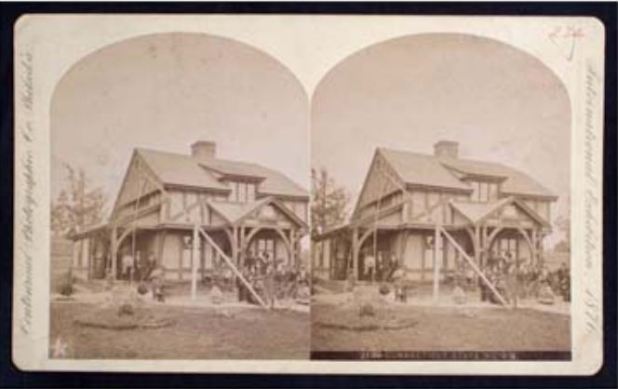By Karen DePauw for Your Public Media
Trivia Question: In which state, besides Connecticut, does a verified grandchild of the Charter Oak tree grow?
Answer: Missouri.
On May 3, 1904, during the Dedication Ceremony of the Connecticut State Building at the Louisiana Purchase Exposition in St. Louis, a seedling from the grounds of Mr. James Holcombe was planted in front of the State Building. That grandchild of the Charter Oak is one piece of evidence that symbolizes Connecticut’s participation in World’s Fairs from the late 19th century through the early 20th century.
Connecticut took part, in both small and large ways, in many of the great World’s Fairs, especially those held in North America. In 1876, the Connecticut State Building at the Centennial Exposition in Philadelphia was modeled after a modest Colonial cottage. At Chicago’s Columbian Exposition of 1893, Connecticut drew inspiration from the grander houses occupied by her founding families. The 1904 building at the Louisiana Purchase Exposition was a direct copy of the Charles and Lydia Sigourney home in Hartford. And the Colonel Talmage home in Litchfield served as inspiration for the building erected in 1907 at the Jamestown Exposition at Jamestown.

Interior of the Connecticut State Building. Stereo view by the Centennial Photographic Co., 1876. Views like these were sold as souvenirs at the Fair – Connecticut Historical Society
Each Connecticut State Building housed collections of antiques loaned by the citizens of Connecticut. The building was meant to give a sense of Connecticut’s rich history and contributions to America.
In addition to its state building, Connecticut also contributed displays to exhibition halls; these featured everything from agriculture and horticulture, to manufacture and industry, to education and liberal arts. Some displays were entirely by one Connecticut company, such as the Underwood Typewriter Co., or the Birdseye and Somers Corset Co. Others were comprehensive exhibits of things such as Connecticut tobacco or shell-fish.
Connecticut’s people have always taken pride in their state, and that pride is evident in the ways that they chose to evoke memories of the Colonial past while celebrating the achievements of the industrial present in their displays at the great World’s Fairs of the late 19th and early 20th centuries.
Karen DePauw is a Research and Collections Associate at The Connecticut Historical Society.
© Connecticut Public Broadcasting Network and Connecticut Historical Society. All rights reserved. This article originally appeared on Your Public Media.
Note: ConnecticutHistory.org does not edit content originally published on another platform and therefore does not update any instances of outdated content or language.









